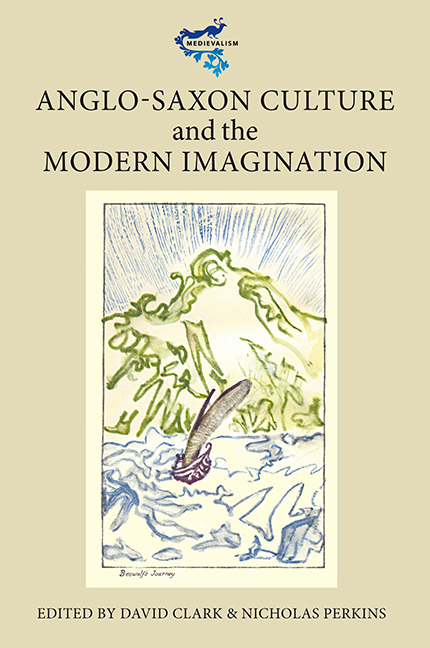Book contents
- Frontmatter
- Contents
- List of Illustrations
- Contributors
- Foreword
- Acknowledgements
- Abbreviations
- Introduction
- 1 From Heorot to Hollywood: Beowulf in its Third Millennium
- 2 Priming the Poets: The Making of Henry Sweet's Anglo-Saxon Reader
- 3 Owed to Both Sides: W.H. Auden's double debt to the literature of the North
- 4 Writing for an Anglo-Saxon Audience in the Twentieth Century: J.R.R. Tolkien's Old English Chronicles
- 5 ‘Wounded men and wounded trees’: David Jones and the Anglo-Saxon Culture Tangle
- 6 Basil Bunting, Briggflatts, Lindisfarne, and Anglo-Saxon Interlace
- 7 BOOO Seeing Beowulf in Pictures and Print
- 8 Window in the Wall: Looking for Grand Opera in John Gardner's Grendel
- 9 Re-placing Masculinity: The DC Comics Beowulf Series and its Context, 1975–6
- 10 P.D. James Reads Beowulf
- 11 Ban Welondes: Wayland Smith in Popular Culture
- 12 ‘Overlord of the M5’: The Superlative Structure of Sovereignty in Geoffrey Hill's Mercian Hymns
- 13 The Absent Anglo-Saxon Past in Ted Hughes's Elmet
- 14 Resurrecting Saxon Things: Peter Reading, ‘species decline’, and Old English Poetry
- Index
6 - Basil Bunting, Briggflatts, Lindisfarne, and Anglo-Saxon Interlace
Published online by Cambridge University Press: 20 April 2017
- Frontmatter
- Contents
- List of Illustrations
- Contributors
- Foreword
- Acknowledgements
- Abbreviations
- Introduction
- 1 From Heorot to Hollywood: Beowulf in its Third Millennium
- 2 Priming the Poets: The Making of Henry Sweet's Anglo-Saxon Reader
- 3 Owed to Both Sides: W.H. Auden's double debt to the literature of the North
- 4 Writing for an Anglo-Saxon Audience in the Twentieth Century: J.R.R. Tolkien's Old English Chronicles
- 5 ‘Wounded men and wounded trees’: David Jones and the Anglo-Saxon Culture Tangle
- 6 Basil Bunting, Briggflatts, Lindisfarne, and Anglo-Saxon Interlace
- 7 BOOO Seeing Beowulf in Pictures and Print
- 8 Window in the Wall: Looking for Grand Opera in John Gardner's Grendel
- 9 Re-placing Masculinity: The DC Comics Beowulf Series and its Context, 1975–6
- 10 P.D. James Reads Beowulf
- 11 Ban Welondes: Wayland Smith in Popular Culture
- 12 ‘Overlord of the M5’: The Superlative Structure of Sovereignty in Geoffrey Hill's Mercian Hymns
- 13 The Absent Anglo-Saxon Past in Ted Hughes's Elmet
- 14 Resurrecting Saxon Things: Peter Reading, ‘species decline’, and Old English Poetry
- Index
Summary
A mason times his mallet
to a lark's twitter,
listening while the marble rests,
lays his rule
at a letter's edge,
fingertips checking
till the stone spells a name
naming none.
(Basil Bunting, Briggflatts, I, p. 61, 14–21)Tortoise deep in dust or
muzzled bear capering
punctuate a text whose initial,
lost in Lindisfarne plaited lines,
stands for discarded love.
(Briggflatts, II, p. 68, 2–6)Ic seah wrætlice wuhte feower
samed siþian; swearte wæran lastas,
swaþu swiþe blacu.
I saw four creatures wondrously travelling together; black were their tracks, so dark their path.
(Exeter Book Riddle 51, 1–3a)This chapter explores how apprehensions of Anglo-Saxon verbal and visual arts resource the poetry of the twentieth-century British modernist poet, Basil Bunting (1900–1985). It is a commonplace of Bunting scholarship that this Northumbrian poet consciously engaged with earlier Northern poetic and visual traditions, including those of the Anglo-Saxons, in the forging of his long modernist poem, Briggflatts (1966). With the important exception of Peter Makin, however, few have explored in any detail how Anglo-Saxon and modernist aesthetics meet in this poem and, of those few, none (as far as I know) have been Anglo-Saxonists. Yet, at the same time that Bunting was working on his poetry, the Old English critic John Leyerle was working on his classic essay on ‘The Interlace Structure of Beowulf ’ (1967). Critic and poet alike are drawn to interlace because of its potential for illuminating early English culture, whether material or verbal. Their shared interest in this subject illustrates the degree to which modern poetic imaginings of the past have points of contact with contemporary scholarship about that past. But this chapter also argues that a better understanding of modern aesthetic appropriations of early English culture can offer us new ways to read the literature of the period itself. If this chapter begins, therefore, in the twentieth century, it ends in the tenth, with a reading of the Old English riddle, Exeter Book Riddle 51, usually solved as ‘a pen with three fingers’.
The first three lines of Exeter Book Riddle 51 constitute the last of the three quotations with which this chapter begins. They image, as is well known to Anglo-Saxonists, the art of writing: the wondrous creatures travel together over the page, leaving a trail or path of black ink. My first quotation offers a different scene of writing.
- Type
- Chapter
- Information
- Anglo-Saxon Culture and the Modern Imagination , pp. 111 - 128Publisher: Boydell & BrewerPrint publication year: 2010



